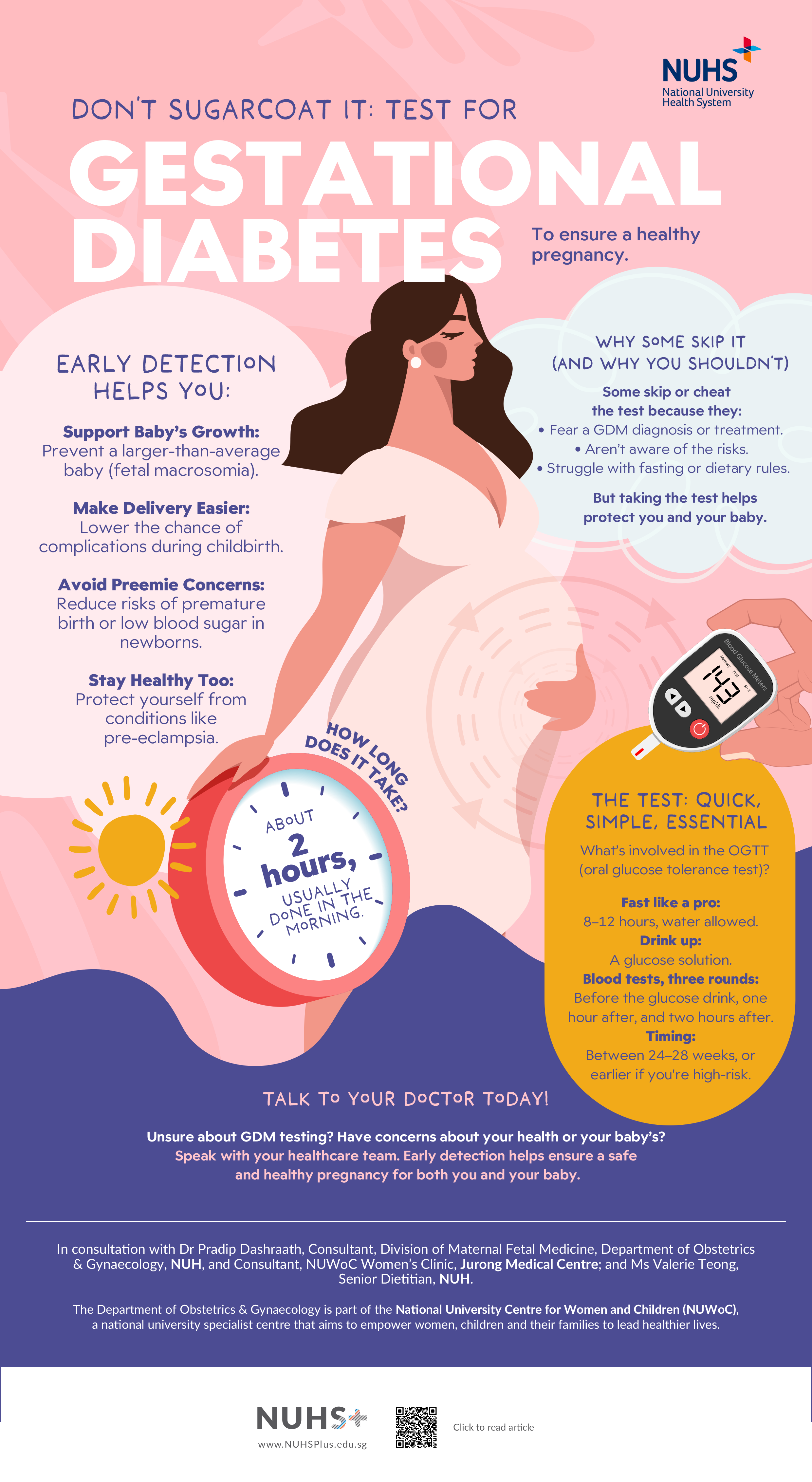GDM can be effectively managed with diet and exercise. A well-balanced diet is crucial for controlling blood sugar levels and ensuring the health of both mother and baby. Presented below are comprehensive strategies for managing GDM.
When you are diagnosed with GDM, we recommend that you monitor your blood sugar levels regularly. Understanding how your body responds to different foods and activities can be achieved by keeping a log and sharing it with your healthcare provider. Your blood sugar levels can often be lowered by making appropriate changes to lifestyle.
In some cases, diet and exercise may not be sufficiently effective to control blood sugar levels. Thus, some women may be started on medications such as metformin or insulin to manage GDM.
Dietary Choices
A dietitian can provide personalised nutrition advice tailored to your diet and lifestyle. Here are some general tips to help you achieve a balanced diet during pregnancy while helping to control blood sugar levels:
1. Eat balanced meals
‘My Healthy Plate’ designed by the Health Promotion Board can be used as a guide to achieve a balanced diet.
- Fill ½ your plate with non-starchy vegetables. They help with stabilising blood sugar levels and help to keep you full.
- Fill ¼ of your plate with protein. Protein helps with the development of healthy babies.
- Fill ¼ of your plate with carbohydrates (choose wholegrains when possible). To maintain blood sugar levels, distribute your carbohydrates evenly throughout the day.
2. Have moderate amounts of carbohydrates
Carbohydrates are important for energy and baby development. You should not avoid carbohydrates completely. Instead, control your portion of carbohydrates. To achieve good blood sugar control, it is recommended to:
- Distribute carbohydrate intake evenly throughout the day. Have 3 meals and 2-3 snacks a day instead of 3 large meals a day.
- Keep to no more than 1 Chinese bowl of rice or noodles per meal and you may have a serving of fruit or a cup of unflavoured milk or yoghurt per snack. Consult your dietitian to tailor the amount of carbohydrates to have at each meal and snack if required.
- Avoid sugary foods like cakes, cookies, nyonya kueh, sweet pastries and desserts.
- Avoid regular soft drinks or sweetened beverages and choose water or zero-sugar drinks or sugar-free beverages instead.
- Watch out for hidden sugars in sauces and gravies like tomato ketchup, chilli sauces, dark soya sauce and sweet and sour sauces, which may increase blood sugar levels.
3. Choose foods that are lower in glycaemic index
When choosing carbohydrates, it is recommended to choose low glycaemic index (GI) foods. The GI measures how quickly a carbohydrate-containing food raises blood sugar levels. Choosing low GI foods like multigrain bread, basmati rice over high GI foods like white bread, white rice or yellow noodles can help maintain more stable blood sugar levels.
4. Enjoy plenty of non-starchy vegetables
Aim for half the plate to be filled with non-starchy vegetables such as green leafy vegetables (choy sum or spinach), gourd vegetables (brinjal or bitter gourd), broccoli and carrots. These non-starchy vegetables contain fibre which can help stabilise blood sugar levels and keep you feeling full longer.
5. Protein foods
Protein foods such as meats, chicken, fish, tofu, eggs, cheese, nuts, and seeds are essential for supporting the growth and development of healthy babies. You should aim to fill a quarter of your plate with protein foods which is equivalent to around a palm size of lean meat, poultry or fish at each meal.
Depending on the stage of pregnancy, amount of weight gain progress and the baby growth scan, your protein requirements might differ. Consult your dietitian if you are concerned about your individual protein needs.
6. Fats and oils
Healthy fats are important for your health and your baby’s growth and development. - Use tiny amounts of healthy oils (e.g., olive, canola, sunflower) in cooking, and include foods like nuts, avocado, and deep-sea fish such as salmon and mackerel as part of your diet. Fats taken excessively can lead to unnecessary weight gain and may cause blood sugar levels to stay high for a longer period.
7. Limit processed foods
Processed foods often contain high levels of sugars, unhealthy fats, and sodium. Excess sugars and unhealthy fats can negatively impact blood sugar control, while high sodium intake can affect blood pressure. Focus on whole, unprocessed foods as much as possible.
8. Stay hydrated
Plain water is the best way to stay hydrated. Otherwise, choose unsweetened beverages in moderation.
9. Food safety
Remember, food safety is important during pregnancy. To prevent food poisoning and keep you and your baby healthy:
- Avoid high risk foods such as soft cheeses, unpasteurised dairy foods, pre-cooked cold chicken, soft serve ice cream, deli/sandwich meats, raw bean sprouts, pre-prepared salads and pâte.
- Avoid raw or undercooked meat, chicken, seafood (for e.g. sashimi) or eggs (for e.g. soft-boiled eggs).
- Follow food cooking and storage instructions.
- Prepare raw and cooked foods separately.
- Cook and reheat food until steaming hot.
- Keep cold foods refrigerated.
- Prepare all salads (including fruit salad) at home.
- Wash fruit and vegetables thoroughly.
- Choose fish carefully and limit intake of shark/flake, swordfish and deep-sea perch because of the risk of these being too high in mercury.
How Much Weight Should You Gain?
Have your weight checked regularly throughout your pregnancy. Healthy weight gain during pregnancy is important for you and your baby. It is usual to gain some weight during your pregnancy, as your baby grows. How much weight you should gain depends on your weight before you were pregnant.
Not gaining enough weight can mean that your baby may not be getting all the nutrition they need.
Gaining too much weight during pregnancy can increase the risk of high blood pressure, having a large baby, birth complications or needing a caesarean section. Extra weight gain can also make it more difficult to manage your blood sugar levels.
The table below shows recommended weight gain during a single pregnancy:
| Pre-pregnancy BMI | Weight range | Pregnancy weight gain (kg) | Monthly weight gain 2nd and 3rd trimester (kg) |
|---|
| < 18.5 | Underweight | 12.5 - 18 | 2 |
| 18.5 - 22.9 | Healthy weight | 11.5 - 16 | 1.5 |
| 23 - 27.5 | Overweight | 7 - 11.5 | 1 |
| > 27.5 | Obese | 5 - 9 | 1 |
Exercise and Lifestyle
Regular physical activity can help with managing your blood sugar levels effectively. It is recommended to engage in at least 150 minutes of moderate-intensity physical activity every week. Activities such as brisk walking in the park, swimming at community pools, and practicing prenatal yoga in local studios are excellent options that can help manage blood sugar levels. In general, ease into your physical activity routine progressively and as everyone’s medical condition is different, it is crucial to seek advice from your doctor before starting any exercise regime.

 Gestational diabetes (GDM) is a type of diabetes that develops during pregnancy. It can happen at any stage of pregnancy, but is more common in the second or third trimester. It can be managed effectively through diet, exercise, and sometimes medication.
Gestational diabetes (GDM) is a type of diabetes that develops during pregnancy. It can happen at any stage of pregnancy, but is more common in the second or third trimester. It can be managed effectively through diet, exercise, and sometimes medication.
















